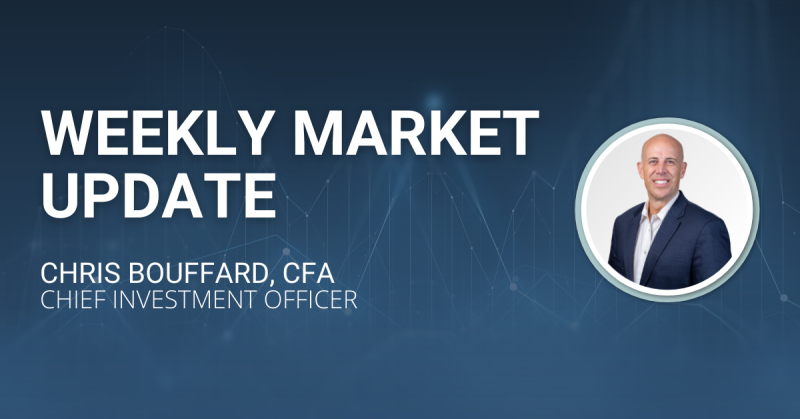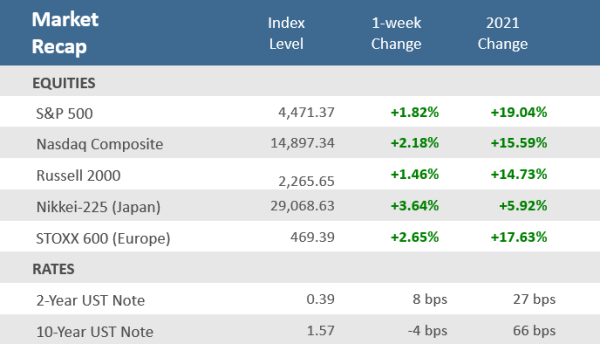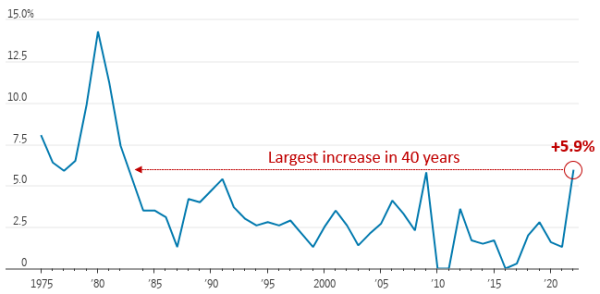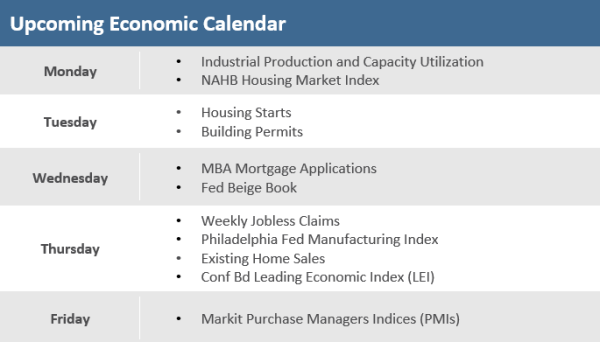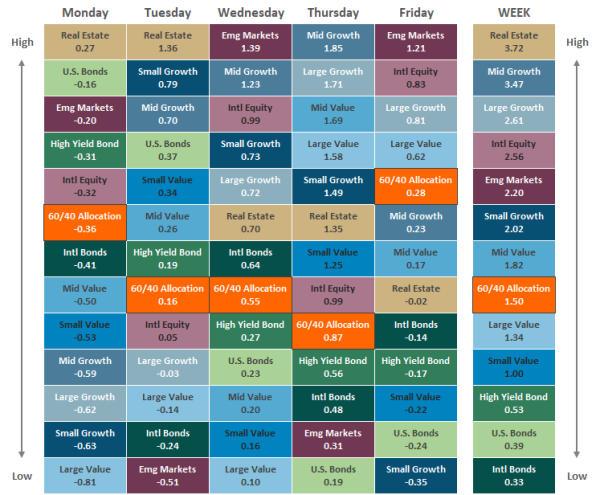Quick Takes
- All asset classes rallied over the week on better-than-expected earnings, encouraging economic data, and reduced coronavirus concerns. The S&P 500 gained +1.8% for its best week since July. The S&P started the week off with another pullback on Monday but rallied Wednesday through Friday to close within 2% of its all-time highs.
- The yield on the U.S. 10-year Treasury finished the week at 1.57%, down -4 basis points from the prior Friday. That helped the Bloomberg Barclays US Aggregate Bond Index to its first weekly advance in the last five weeks.
- On balance economic data was very encouraging with highlights including much stronger than expected retail sales and the first week of jobless claims under 300,000 since the start of the pandemic.
Earnings and economic reports power markets higher
For the fourth week in a row, stocks have opened with a negative Monday, but stocks have rallied to close the week positive for the past two weeks. Investors shrugged off higher inflation readings and instead focused on better-than-expected earnings, primarily from banks and insurers, as well as solid retail sales and the lowest weekly unemployment claims since the pandemic began. The S&P 500 was up +1.8% for the week, its best week since July. The technology-heavy Nasdaq Composite was up even more with a +2.2% gain. In terms of style trends, Growth stocks beat Value stocks, and Small stocks beat Large stocks. It wasn’t just equities that were up. In fact, all major asset classes saw gains, led by Real Estate. For the last few weeks, bonds had been hampered by rising interest rates. Still, they managed their first positive week in the last five as the yield on the US 10-year Treasury note declined to 1.57% from 1.61% the prior Friday (bonds generally move in the opposite direction as interest rates). It was only the first week of the Q3 earnings reporting season, but according to FactSet 80% of the 41 S&P 500 companies that reported earnings topped earnings-per-share expectations. The current blended earnings growth rate is about 30%. The minutes from the September meeting of the Federal Open Market Committee (FOMC) were released Wednesday and the Fed said it plans to taper its purchases of Treasuries by $10 billion per month and mortgage-backed securities by $5 billion, and that asset purchases would end by next summer.
Chart of the Week
The Social Security Cost-Of-Living Adjustment (COLA) in 2022 will be +5.9%, according to the Social Security Administration, making it the largest increase to COLA in 40 years, and a reflection of inflation since the pandemic. For more than a decade, these adjustments have averaged below 2% a year. However, in dollars and cents terms, the increase remains somewhat modest. The average Social Security benefit is approximately $1,543 a month. A +6% increase would equate to about $93 – certainly a boost to older Americans on a fixed income, but not on par with high, and more rapidly rising, healthcare, energy, and housing costs.
Refreshing COLA
Social Security cost of living adjustments (COLA)
Note: Adjustments were effective with benefits received in July between 1975-82 and benefits received in January after 1982. Social Security Administration data show no adjustment was made in 1983.
Source: Social Security Administration, The Wall Street Journal.
Economic Review
- The September National Federation of Independent Business (NFIB) Small Business Optimism Index slipped to 99.1 from 100.1 in August and slightly below expectations of 99.5. The report showed that inflation and labor shortages continue to impact business operations and that business owners have concerns about tax increases and additional regulations.
- The Labor Department’s Job Openings and Labor Turnover Survey (JOLTS), which measures labor demand, reported that job openings fell 659,000 to 10.44 million in August, which was well under expectations of 10.95 job openings. The report showed that the hiring rate declined to 4.3% from July’s 4.6% pace, and separations rose to 4.1% from the previous month’s 3.9% pace. The number of Americans voluntarily quitting their jobs surged to a record high in August as quits increased by 242,000, lifting the total to a record 4.3 million, and shot the quits rate to an all-time high of 2.9% from 2.7% in July. The higher quits rate suggests wage inflation will likely continue to build up as companies scramble for workers, who now have many choices.
- Consumer inflation accelerated last month and remained at its highest rate in over a decade. The Consumer Price Index (CPI) beat expectation in September with a rise of +0.4% month-over-month and was up from the unrevised +0.3% gain in August. The core rate, which excludes food and energy, increased +0.2%, in line with expectations, and was also above August’s unadjusted 0.1% rise. Year-over-year prices were up +5.4%, the same rate as in June and July as the economy reopened, and above forecasts of +5.3% rise. Core CPI was up +4.0% over last year, matching forecast and August’s unrevised rate. The Bureau of Labor Statistics (BLS) said prices for food and shelter rose in September and combined contributed more than half to the headline figure, while energy prices were also higher.
- A separate Labor Department report on Thursday showed producer inflation also rising. The Producer-Price Index (PPI), a measure of prices that suppliers are charging businesses and other customers, rose +0.5%, a bit below estimates for a +0.6% gain and less than August’s +0.7%. Core PPI, which excludes food and energy, was up +0.2%, was below expectations of +0.5%, and below August’s +0.6% gain. Year-over-year PPI was up +8.6%, which was a bit below expectations for +8.7% but was above the +8.3% in August. Core PPI was up +6.8% from last year, short of estimates for a +7.1% rise but above August’s 6.7% increase.
- The September Federal Open Market Committee (FOMC) meeting minutes noted that the Fed could start scaling back the $120 billion in monthly purchases of Treasury and mortgage securities in mid-November or mid-December. The Fed may begin cutting $10 billion a month in Treasury purchases and $5 billion monthly in mortgage-backed securities, with a target date to end purchases by mid-2022. The next FOMC meeting is slated for November 2-3.
- Initial Jobless Claims fell much more than expected, to 293,000 versus forecasts for 320,000, and below a downwardly revised 329,000 the prior week. Continuing Claims fell to 2.593 million, better than the 2.670 million forecast and the revised 2.727 million the prior week.
- On Friday the Commerce Department reported that the advanced September Retail Sales reading was up +0.7% from August, far ahead of expectation for a decline of -0.2% as consumers shrugged off supply constraints, the Delta variant, and the end of enhanced unemployment benefits. August’s reading was also revised higher to +0.9% from +0.7%.
- The October preliminary University of Michigan Consumer Sentiment Index fell to 71.4, below estimates of 73.1 and September’s 72.8 reading. The index posted the second-lowest reading since 2011 as both the current conditions and expectations portions of the index fell.
The Week Ahead
Next week economic reports will likely take a back seat to the ramp up in Q3 earnings reports. Housing will be a big theme with homebuilder sentiment, housing starts, building permits, and existing home sales all on the docket. Industrial Production and the Fed’s Beige Book should shed more light on the health of the recovery and the inflation situation.
Did You Know?
TRICK OR TREAT? — While October may have a bad market reputation, the fourth quarter has been mostly positive for stocks. The S&P 500 Index has averaged outsized gains of +3.9% in the fourth quarter and has gained four out of every five years since World War II. The next-best quarter is the first, with an average gain of +2.3%. The worst is the third, up just +0.6%. The S&P 500 eked out a small gain for the third quarter of 2021 but was down nearly -5% in September. October is often remembered for stock market crashes like those in 1929 and 1987, but the market has historically been positive for the month. Moreover, the S&P 500 has typically gained in the fourth quarter when it already has healthy year-to-date gains heading into it. (Source: CFRA, Bespoke Investment Group, MFS Investment Management).
GOING UP? — The total household net worth in America is up +47% in the last 4 years and is up +89% in the last 8 years. The total US household net worth was $74.8 trillion as of 6/30/2013, was $96.2 trillion as of 6/30/2017, and was $141.7 trillion as of 6/30/2021 (Source: Federal Reserve, BTN Research).
CO-BUYERS SURGE — Since 2014, when millennials became the largest share of homebuyers in the U.S., the number of home and condo sales across the country by co-buyers has soared. The number of co-buyers with different last names increased by +771% between 2014 and 2021 (Source: Attom Data Solutions, The Wall Street Journal).
This Week in History
The single-best trading day for the S&P 500 in the last 71 years (since 1950) took place 13 years ago this week, on Monday 10/13/2008 – a gain of +11.58% (total return) in just 1 trading day. It was also this week in 1990 that the great bull market of the 1990s began in which stocks would more than quadruple over the next ten years (Source: BTN Research, The Wall Street Journal).
Asset Class Performance
The Importance of Diversification. Diversification mitigates the risk of relying on any single investment and offers a host of long-term benefits, such as lowering portfolio volatility, improving risk-adjusted returns, and helping investments to compound more effectively.
Source: Bloomberg. Asset‐class performance is presented by using market returns from an exchange‐traded fund (ETF) proxy that best represents its respective broad asset class. Returns shown are net of fund fees for and do not necessarily represent the performance of specific mutual funds and/or exchange-traded funds recommended by The Retirement Planning Group. The performance of those funds may be substantially different than the performance of the broad asset classes and to proxy ETFs represented here. U.S. Bonds (iShares Core U.S. Aggregate Bond ETF); High‐Yield Bond (iShares iBoxx $ High Yield Corporate Bond ETF); Intl Bonds (SPDR® Bloomberg Barclays International Corporate Bond ETF); Large Growth (iShares Russell 1000 Growth ETF); Large Value (iShares Russell 1000 Value ETF); Mid Growth (iShares Russell Mid-Cap Growth ETF); Mid Value (iShares Russell Mid-Cap Value ETF); Small Growth (iShares Russell 2000 Growth ETF); Small Value (iShares Russell 2000 Value ETF); Intl Equity (iShares MSCI EAFE ETF); Emg Markets (iShares MSCI Emerging Markets ETF); and Real Estate (iShares U.S. Real Estate ETF). The return displayed as “Allocation” is a weighted average of the ETF proxies shown as represented by: 30% U.S. Bonds, 5% International Bonds, 5% High Yield Bonds, 10% Large Growth, 10% Large Value, 4% Mid Growth, 4% Mid Value, 2% Small Growth, 2% Small Value, 18% International Stock, 7% Emerging Markets, 3% Real Estate.
Chris Bouffard is CIO of The Retirement Planning Group (TRPG), a Registered Investment Adviser. He has oversight of investments for the advisory services offered through TRPG.
Disclaimer: Information provided is for educational purposes only and does not constitute investment, legal or tax advice. All examples are hypothetical and for illustrative purposes only. Past performance of any market results is no assurance of future performance. The information contained herein has been obtained from sources deemed reliable but is not guaranteed. Please contact TRPG for more complete information based on your personal circumstances and to obtain personal individual investment advice.

